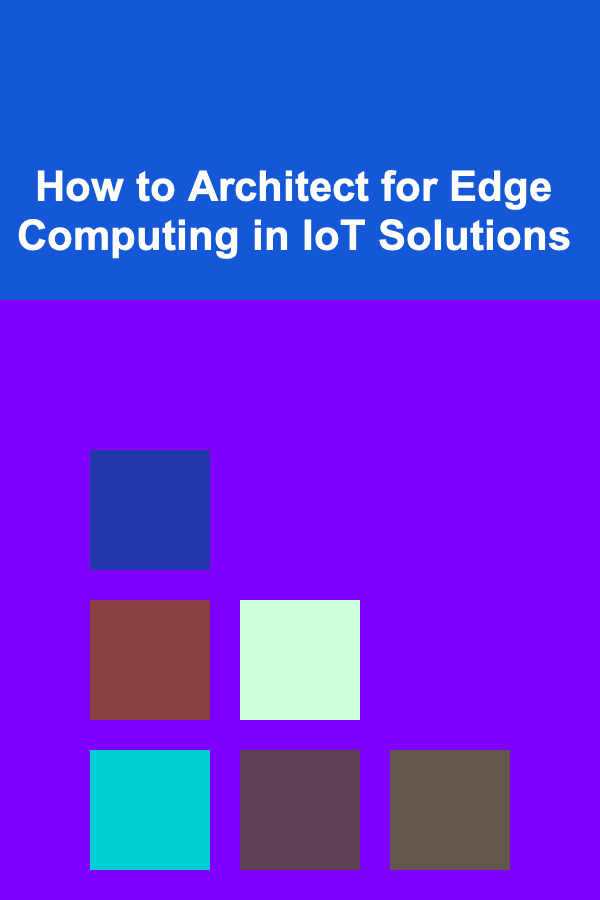
How to Architect for Edge Computing in IoT Solutions
ebook include PDF & Audio bundle (Micro Guide)
$12.99$7.99
Limited Time Offer! Order within the next:

Edge computing has emerged as a transformative paradigm in the Internet of Things (IoT) ecosystem. By processing data closer to where it is generated (i.e., at the edge of the network), edge computing can dramatically improve the performance, scalability, and efficiency of IoT solutions. As IoT devices proliferate across industries---from smart homes and factories to autonomous vehicles and healthcare systems---there is an increasing need to architect systems that leverage the power of edge computing.
In this article, we will explore the core principles and best practices for architecting IoT solutions with edge computing. From understanding the benefits and challenges to defining the components and technologies involved, we will provide a comprehensive guide for designing efficient, scalable, and secure IoT architectures that take full advantage of edge computing capabilities.
Understanding Edge Computing in IoT
Edge computing refers to the practice of processing data closer to the location where it is generated, rather than sending it to a centralized cloud or data center for analysis. This localized processing allows for faster decision-making, reduced latency, and improved overall system efficiency. In the context of IoT, edge computing helps manage the massive amounts of data generated by connected devices, enabling real-time insights and actions that are crucial for many IoT applications.
The Need for Edge Computing in IoT
IoT devices generate vast amounts of data---far more than traditional computing systems can handle efficiently. Transmitting all this data to the cloud or a centralized server for processing can lead to several challenges:
- Latency: Delays in sending data to remote servers and waiting for a response can negatively impact real-time decision-making. This is particularly critical in applications like autonomous vehicles, industrial automation, and healthcare monitoring.
- Bandwidth: Sending large volumes of data to a centralized server can strain network bandwidth, leading to inefficiencies and increased costs.
- Security and Privacy: Transmitting sensitive data to remote servers increases the risk of data breaches and cyberattacks, especially in regulated industries such as healthcare and finance.
- Scalability: As the number of connected devices grows, cloud-based systems may struggle to keep up with the sheer volume of data and the need for real-time processing.
By bringing computation closer to the edge, edge computing helps address these challenges, providing a more efficient and effective solution for IoT applications.
Key Components of Edge Computing in IoT Architectures
To design an effective IoT solution that leverages edge computing, it's essential to understand the key components involved in such architectures. These components work together to ensure that data processing, storage, and analysis occur efficiently at the edge.
2.1. IoT Devices and Sensors
The foundation of any IoT system is the devices and sensors that generate the data. These devices can range from simple sensors that monitor temperature, humidity, or motion to more complex devices like cameras, wearables, or machinery that produce large amounts of data in real time. Edge computing brings the computation closer to these devices, allowing for faster processing and reducing the dependency on centralized servers.
2.2. Edge Gateways
Edge gateways serve as intermediaries between IoT devices and the cloud. They play a crucial role in an edge computing architecture by processing and filtering data at the edge before it is transmitted to a centralized server or cloud. Gateways may handle tasks such as:
- Data pre-processing: Aggregating, filtering, and transforming raw sensor data into usable insights.
- Data storage: Storing temporary data at the edge for quick retrieval or offline analysis.
- Protocol translation: Converting data between different communication protocols used by IoT devices and cloud systems.
- Security management: Ensuring that sensitive data is encrypted and protected at the edge.
Gateways help reduce the volume of data that needs to be transmitted to the cloud, ensuring that only relevant data is sent for further analysis.
2.3. Edge Devices
Edge devices are specialized hardware designed to perform computation and data storage at the edge of the network. These devices come in various forms, including:
- Edge servers: Small, compact servers located close to IoT devices for local computation and storage.
- Embedded systems: Custom-built devices embedded within machines or infrastructure that handle specific tasks, such as image processing or machine learning.
- Microcontrollers: Low-power devices designed to perform small-scale computations locally, often in battery-operated IoT devices.
These edge devices are responsible for processing and analyzing data in real-time, making immediate decisions based on the data received from sensors or IoT devices.
2.4. Cloud Integration
While edge computing focuses on processing data locally, cloud integration remains an essential part of the overall architecture. The cloud acts as a centralized platform for long-term storage, analytics, and remote management. In most IoT solutions, edge computing and cloud computing work together in a hybrid approach, where the edge handles real-time processing, and the cloud handles deeper analysis and long-term data storage.
2.5. Data Storage
Efficient data storage at the edge is essential for IoT solutions. While edge devices may not have the capacity to store vast amounts of data, they can store temporary data locally for quick access or processing. Additionally, edge gateways may facilitate storage by collecting and caching data before it is transmitted to the cloud.
Design Considerations for Edge Computing in IoT
When designing an IoT solution with edge computing, there are several important considerations to take into account. These considerations will help ensure that your architecture is efficient, scalable, and secure.
3.1. Latency and Real-Time Processing
One of the primary benefits of edge computing is reduced latency, as data is processed closer to the source. In IoT applications that require real-time decision-making, such as autonomous vehicles or industrial robots, minimizing latency is critical. To achieve this:
- Data filtering and aggregation: Process data at the edge to reduce the volume of information sent to the cloud. For example, you may only transmit summarized data or events that exceed certain thresholds.
- Edge-based decision-making: Implement algorithms and machine learning models on edge devices to enable real-time decision-making without relying on the cloud.
3.2. Scalability
IoT systems are inherently scalable, as the number of connected devices continues to grow. Edge computing must be designed to scale efficiently to handle an increasing volume of devices and data. Key approaches to scalability include:
- Modular edge devices: Use flexible and modular edge devices that can be easily expanded or upgraded as the IoT network grows.
- Distributed edge computing: Distribute processing across multiple edge nodes to prevent bottlenecks and improve fault tolerance.
3.3. Security
Security is a critical concern in any IoT system, and edge computing adds an extra layer of complexity due to the distributed nature of the architecture. To secure your IoT solution:
- Encryption: Use encryption to protect data at rest and in transit between edge devices and cloud servers.
- Authentication and authorization: Implement strong authentication and access control mechanisms to ensure that only authorized devices and users can interact with the edge devices and network.
- Edge device monitoring: Continuously monitor the health and performance of edge devices to detect potential vulnerabilities or attacks.
3.4. Power Efficiency
Many IoT devices are battery-operated or deployed in environments where power is limited. Edge computing architectures must be designed with power efficiency in mind, particularly for devices that need to operate autonomously for extended periods. To achieve power efficiency:
- Low-power edge devices: Use low-power edge computing devices such as microcontrollers or single-board computers that can handle computation without consuming excessive energy.
- Edge data processing: Perform as much computation as possible at the edge to reduce the need for continuous communication with the cloud, which can consume significant amounts of power.
3.5. Interoperability
Interoperability between different devices, platforms, and communication protocols is crucial in IoT systems. Edge computing architectures must be designed to handle diverse IoT standards and protocols, such as MQTT, CoAP, and HTTP, to ensure seamless communication between devices and cloud systems.
Technologies Enabling Edge Computing in IoT
Several technologies enable the implementation of edge computing in IoT solutions. These technologies help optimize the performance, scalability, and security of edge computing architectures.
4.1. Fog Computing
Fog computing is a distributed computing model that extends cloud computing capabilities to the edge of the network. It provides a more granular approach to data processing, enabling computation to be done not just at the edge, but also in intermediate nodes between the edge and the cloud. Fog computing can help reduce latency, improve scalability, and manage data more efficiently in IoT networks.
4.2. 5G Networks
The advent of 5G technology promises to enhance edge computing capabilities by providing high-speed, low-latency connectivity. 5G networks enable faster communication between IoT devices, edge gateways, and the cloud, making it possible to handle more devices and data in real-time. This is particularly important for applications that rely on rapid decision-making, such as autonomous vehicles and industrial automation.
4.3. AI and Machine Learning at the Edge
Machine learning and AI algorithms can be deployed directly on edge devices to enable real-time analysis and decision-making. By processing data locally, AI-powered edge devices can identify patterns, detect anomalies, and optimize performance without the need to send data to the cloud. This is especially useful in IoT applications such as predictive maintenance, security monitoring, and smart cities.
4.4. Edge-Oriented Data Storage Solutions
Edge data storage solutions, such as distributed databases and decentralized file systems, are essential for handling the vast amounts of data generated by IoT devices. These storage systems allow data to be stored locally at the edge and synchronized with the cloud when necessary. Technologies like blockchain and decentralized storage networks also play a role in ensuring the security and integrity of data at the edge.
Best Practices for Architecting Edge Computing in IoT Solutions
To create a robust and scalable IoT architecture using edge computing, it is essential to follow best practices that maximize the effectiveness of the solution. These best practices include:
5.1. Start with a Modular Approach
Design your IoT system with modularity in mind. Use scalable edge devices, flexible communication protocols, and reusable components that can be easily updated or expanded as your IoT network grows.
5.2. Prioritize Data Locality
Whenever possible, prioritize processing data at the edge rather than transmitting it to the cloud. This minimizes latency and bandwidth usage and ensures that decisions can be made in real-time.
5.3. Implement Edge Analytics
Leverage edge analytics to process data locally and gain insights in real-time. This approach reduces the load on cloud servers and enables faster decision-making.
5.4. Design for Security from the Start
Security should be a top priority when designing edge computing architectures. Implement encryption, secure communication protocols, and access controls to protect both the edge devices and the data they handle.
5.5. Plan for Long-Term Scalability
As the number of connected IoT devices grows, your edge computing architecture must be able to scale seamlessly. Design your system with the flexibility to add more edge devices, storage capacity, and processing power as needed.
Conclusion
Edge computing is revolutionizing the way IoT solutions are architected by enabling faster, more efficient data processing closer to the source. By understanding the key components, design considerations, and technologies involved, businesses can build robust IoT systems that deliver real-time insights, improved scalability, and enhanced security. Architecting for edge computing in IoT requires careful planning and a focus on power efficiency, interoperability, and security, but the benefits it offers in terms of performance and cost savings make it a compelling choice for modern IoT applications. By leveraging edge computing, organizations can unlock the full potential of their IoT networks, creating smarter, more responsive systems across industries.
Reading More From Our Other Websites
- [Home Holiday Decoration 101] How to Turn Your Home Into a Holiday Haven with Layers of Decor
- [Organization Tip 101] How to Use Pull-Out Shelves for Easy Access to Items
- [Home Pet Care 101] How to Make a Cat-Friendly Garden That Is Safe and Stimulating for Your Feline Friend
- [Home Storage Solution 101] How to Maximize Your Outdoor Space with Smart Bike Storage Solutions: Weatherproof Options for Apartments and Homes
- [Home Soundproofing 101] How to Soundproof a Ceiling: Effective Techniques to Block Noise from Above
- [Home Maintenance 101] How to Keep Your Plumbing in Top Shape
- [Organization Tip 101] How to Use Drawer Organizers in Your Kitchen
- [Hiking with Kids Tip 101] Keeping the Fun Rolling: Engaging Activities for Toddlers on the Trail
- [Home Lighting 101] How to Create the Perfect Lighting for Your Home's Reading Nook
- [Home Soundproofing 101] How to Soundproof Doors for a Quieter Home

Building a Robust Quality Assurance Framework: Strategies and Case Studies for Success
Read More
How to Maximize Storage During a Home Renovation
Read More
How to Tackle Tough Stains on Carpets and Upholstery
Read More
How to Meal Plan Around Sales and Seasonal Produce
Read More
10 Tips for Building a High-Performing QA Team
Read More
10 Tips for Hosting Successful Gallery Openings
Read MoreOther Products

Building a Robust Quality Assurance Framework: Strategies and Case Studies for Success
Read More
How to Maximize Storage During a Home Renovation
Read More
How to Tackle Tough Stains on Carpets and Upholstery
Read More
How to Meal Plan Around Sales and Seasonal Produce
Read More
10 Tips for Building a High-Performing QA Team
Read More